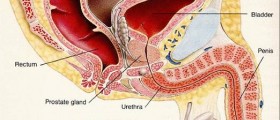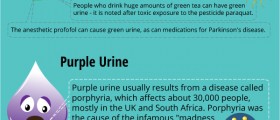When a man is healthy, his urine is clear, usually yellow in color and with mild smell. However, kidneys are responsible for the production of urine, and all toxins and chemicals from the body are excreted this way. Urea is the component which gives specific odor to urine, and the smell is more prominent if there is a higher concentration of urea. Concentrated urine is smellier than diluted one.
Causes of Smelly Urine
Changes in the color and smell of urine can be temporary and not so serious condition, but it could also indicate more severe disease or disorder.
Dehydration is one of frequent cause of smelly urine in men, especially if they are living in hot climates. Men that exercise a lot and lose large amount of fluids from the body, without compensating that with sufficient amount of water are also prone to this condition. Their urine tends to be very concentrated and have strong smell, because of the ammonia in it.
Bladder infection or cystitis is more likely to develop in women, but it can happen to men, too. Urethra becomes infected with bacteria, and the infection spreads to the prostate and bladder. These people experience burning while urinating and frequent need to urinate, as well. Urinary tract infections are also recognized as the cause of smelly urine in men. Poor diet, weak immune system, stress or sexual contact with the person infected with Escherichia coli bacteria might lead to infections of urinary tract in men.
Patients suffering from diabetes can also experience smelly urine. Their urine smells sweet, because of the glucose in it.
MSUD or maple syrup urine disease is genetic disorder. The body of these patients can’t metabolize some amino acids, such as valine, leucine and isoleucine, and their kidneys secrete urine that smells like maple syrup.
Eating asparagus or using vitamin B6 supplements is often found to provoke smelly urine in men. Kidney stones or infections and liver failure can also lead to the same symptom.
Since urine contains a complex mixture of components, volatile organic compounds patterns are evident only after considerable computer processing of chromatographic data. In addition, considerable variation among individuals has been found in profiles of urine-derived volatiles. Notably, urinary components are affected not only by the metabolic status of the body, but also significantly by ingested foods and drinks.
Metabolic disorders derived from enzyme deficiencies or transport defects often result in the accumulation of particular metabolites in body fluids due to impairment in normal biochemical pathways. Some of them manifest in the urine:
- Phenylketonuria is an inherited autosomal recessive disorder characterized by hyperphenylalaninemia resulting from deficiency of hepatic phenylalanine hydroxylase, which converts phenylalanine into tyrosine. Phenylalanine hydroxylase deficiencies result in the accumulation of phenylalanine, which is abnormally metabolized to phenylpyruvic acid and phenylacetate.
- Maple syrup urine disease is a defect in the metabolism of the branched-chain amino acids (BCAAs), valine, leucine and isoleucine. This disease leads to mental retardation and cerebral degeneration, and is caused by the deficiency of an enzyme activity that catalyses oxidative decarboxylation of 2-oxocarboxylic acids in the degradation of the BCAAs. As a result of this enzyme deficiency, 2-oxocarboxylic acids and their corresponding reduced products accumulate in tissues, blood, cerebro-spinal fluid and urine. Consequently, the characteristic maple syrup or caramelized sugar-like odour is found in sweat and urine and even cerumen. This symptomatic odour is evident during the first week after birth, and therefore, the correct diagnosis and dietary management (e.g. consumption of BCAA-free foods) must be started immediately upon diagnosis and soon after birth.
- Methionine malabsorption syndrome is an autosomal recessive inherited disease caused by malabsorption of methionine. Some portion of unabsorbed methionine is converted to ?-hydroxybutyric acid by intestinal bacteria, and the acid causes a yeast-, malt-, or hop-like odour in the patient's urine.
- Hypermethioninemia (Methionine adenosyltransferase deficiency) is a key enzyme in transmethylation, transsulphuration and the biosynthesis of polyamines. Genetic deficiency of ?/?-methionine adenosyltransferase causes hypermethioninemia and neural demyelination. In some cases, patients exhibit breath, sweat and/or urine with a cabbage-like odour that is due to the presence of unusually large amounts of dimethylsulphide, a metabolite of methionine.
- Trimethylaminuria (TMAU) is a metabolic disorder characterized by the inability of individuals to oxidize trimethylamine (TMA) to trimethylamine N-oxide (TMAO). This disorder results from an autosomal recessive mutation in the gene encoding flavin-containing monooxygenase enzyme 3. TMA is produced in the gut by bacterial metabolism of choline-rich foods, such as eggs, certain legumes and organ meat. The unmetabolized TMA is excreted in urine, sweat, breath, saliva and reproductive fluid. Therefore, the inability to efficiently oxidize TMA results in a foul, unpleasant and fish-like body odour.
- Diabetes/diabetic ketoacidosis. Glucose is the main source of energy for cells of the body and insulin, a hormone made by the pancreas, signals cells to take up glucose. Since patients with type 1 diabetes cannot synthesize insulin, glucose accumulates in the blood, and is excreted in the urine. Under these conditions, cells use fatty acids rather than glucose as an energy source. However, fatty acid catabolism creates ketone compounds, such as acetoacetate, 3-hydroxybutyrate and acetone, as by-products and these ketone bodies cause blood acidity, leading to ketoacidosis of the blood. These excess ketones are secreted in the urine and breath. As a result, the patient's urine and breath have a fruity odour due to the presence of acetone.
How to Treat Smelly Urine in Men
When your urine starts to smell differently, first thing you should do is to hydrate your body. Drink plenty of water or some other fluids. Many doctors agree that about 2l of clear water is sufficient to improve the smell of your urine.
Teaspoon of honey and unsalted yogurt, cranberry juice and raw cranberries are suggested as natural urinary antiseptics, which may help you with some urinary infections.
Some people might get medications for smelly urine, such as amoxicillin, cephalosporins, doxycycyline, quinolones, sulfa drugs or trimethoprim-sulfamethoxazole.


















Your thoughts on this
Loading...